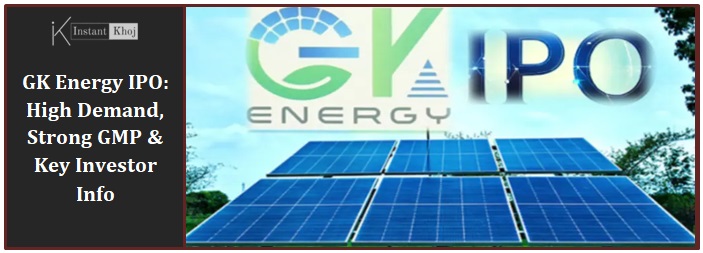Introduction
GK Energy Ltd, a Pune‑based company specializing in solar‑powered agricultural water pump systems, is making waves in the IPO market. Its Initial Public Offering (IPO) opened on September 19, 2025, and is scheduled to close on September 23, 2025. As of September 22, the IPO has seen impressive subscription rates and strong interest in the grey market. With so many moving pieces — pricing, valuation, governmental policy exposure, and demand from both institutional and retail investors — it’s important to unpack all the details. This article dives into what GK Energy does, the structure and pricing of the IPO, how it’s performing in subscriptions and GMP, what analysts are saying, what risks investors should keep in mind, and whether this could be a worthwhile investment.
Who Is GK Energy & What Are Its Business Credentials
GK Energy operates in the EPC (Engineering, Procurement & Construction) domain with a niche focus: solar‑powered agricultural water pump systems (SPPS). Key features:
-
It is deeply involved with the PM‑KUSUM scheme (Component B), a government initiative in India aiming to promote solar-powered pumps among farmers. This gives the company a steady policy-backed demand pipeline.
-
It has already installed over 62,500 solar pumps (≈ 62,559 installations) as of mid‑2025. These are spread over several states including Maharashtra, Haryana, Rajasthan, Uttar Pradesh, etc.
-
Its financial growth in recent years has been substantial: revenues increased from about ₹285 crore in FY23 to approximately ₹1,095 crore by FY25. Also, profit after tax (PAT) grew correspondingly.
-
The company uses an “asset light” model for many operations and is planning backward integration (e.g. proposals for solar module manufacturing plant capacity in Maharashtra) to reduce dependence on external suppliers.
These credentials make GK Energy appealing to investors who believe in renewable energy, government‑supported green infrastructure, and companies with scalable business models.
IPO Structure, Pricing & Key Details
Here are the nuts and bolts of the GK Energy IPO:
Parameter | Detail |
|---|---|
| Total Issue Size | ~ ₹464.26 crore IPO. This includes a fresh issue of ~ ₹400 crore and an Offer for Sale (OFS) by promoters of ~ 42 lakh shares (worth about ₹64.26 crore at the upper price band). |
| Price Band | ₹145 ‑ ₹153 per share. This is the range within which investors can bid. |
| Face Value | Each share has a face value of ₹2. |
| Lot Size | Minimum lot size of 98 shares. So if you apply, you need to apply in multiples of 98. |
| Use of Proceeds | Of the fresh issue funds: ~ ₹322.5 crore will go to long‑term working capital. The remaining portion will be used for general corporate purposes. Promoters will sell shares under the OFS part. |
| Anchor Investors | Before the IPO opened, GK Energy raised ~ ₹139.27 crore from anchor investors. 91.03 lakh shares were allotted to 13 anchor funds at ₹153 per share (upper band). Some anchor investors include Pinebridge Global Funds, 3P India Equity Fund, HSBC Mutual Fund, etc. |
| IPO Open / Close Dates | Subscription window open from September 19, 2025 through September 23, 2025. |
| Tentative Allotment & Listing Dates | Allotment expected ~ September 24, listing on NSE/BSE likely ~ September 26, 2025. |
Subscription Progress & Grey Market Premium (GMP)
These indicators show how the IPO is being received by the market and what people expect in terms of listing gains.
-
Day‑1, when bidding started (September 19), the IPO was subscribed ~ 2.57× overall. That means demand was about 2.57 times the shares on offer.
-
As of Day‑2 (September 22), subscription has jumped significantly. The IPO is now subscribed more than 5×. The Non‑Institutional Investors (NIIs) category is leading the demand.
-
Regarding GMP: reports indicate the grey market premium is around ₹25 per share (i.e. shares are trading about ₹25 above the upper end of the issue price in unofficial markets). This implies an expected listing price near ₹178 (₹153 + ₹25).
-
However, some caution: one report notes that GMP has “cooled” down compared to earlier days. For instance, Financial Express mentions GMP dropping to around 14% on Day 2 from earlier higher levels.
Analyst View & Valuation
What market observers and analysts are saying:
-
Many analysts are calling the GK Energy IPO a “Subscribe – Long Term” type of issue. The rationale: strong business growth, good order book, potential tailwinds from government renewal energy programs.
-
Valuation metrics appear reasonable given the growth. For example, revenue growth is very steep (from ~ ₹285 crore in FY23 to ~ ₹1,095 crore by FY25), which suggests strong operating momentum. Profitability too has shown improvement.
-
Some analyst concerns: dependency on government subsidy schemes like PM‑KUSUM (which have finite lifecycles), dependency on a limited number of suppliers, geography concentration, and competitive pressures from imports, etc. These are flagged in risk disclosures.
Risks & Caveats Investors Must Know
Even with strong demand and positive sentiment, there are non‑trivial risks:
-
Policy & Subsidy Dependency
GK Energy’s business is heavily tied to government programs (especially PM‑KUSUM). If those schemes change, wind down, or face delays, demand could suffer. -
Geographic Concentration
Many of its operations are in certain states. If those states suffer from regulatory or economic issues, farming demand drops, or subsidy execution issues, GK Energy might face headwinds. -
Supplier / Component Risk
Components for solar pumps (panels, motors, electronics) are subject to global supply chain pressures, commodity price fluctuations, etc. Any delay or rise in component cost directly hits margins. -
Valuation / GMP Expectations Might Be High
With GMP expecting +₹25 (approx +16‑17%), the market is pricing in relatively high listing gains. If the actual listing or after‑market trading falls short, there could be a correction. Investors need to be mindful that GMP is unofficial and subject to change until listing. -
Seasonality & Demand Variation
Agricultural demand can fluctuate with seasons, rainfall, and local power availability. Solar pumps are more used in some seasons than others; these cycles might affect revenue timing. Also, weather and climatic conditions can impact installation schedules.
What It Means for Different Types of Investors
Here’s how this IPO might look depending on your investment style.
Investor Type | How This IPO Might Appeal | What to Watch Out For |
|---|---|---|
| Long‑Term Investors / Growth Oriented | Strong story: renewable energy, solar pump installations, policy support, rapidly rising revenue. Good potential if you believe in clean energy growth. | Need patience. Policy risk, subsidy dependence, competition. Make sure you’re comfortable with fluctuations. |
| Retail Investors Looking for Listing Gains | GMP suggests potential listing premium. Lower price band makes entry easier. Strong demand implies oversubscription gives some chance of allotment. | GMP is not guaranteed profit. Subscription might be very high, allotment for retail small; possibility of listing price being volatile. |
| Institutional Investors / Mutual Funds | Anchor round already shows strong institutional interest. The growth numbers and scalable model are promising. | Valuation, execution risk, component cost inflation, operational efficiency will matter. Also, lock‑in, return metrics critical. |
Latest Data & What’s Changing (as of September 22, 2025)
-
Subscription has crossed 5× on Day 2. This strong demand is driven by NIIs and retail interest.
-
GMP is around ₹25 per share, putting expected listing around ₹178. This reflects market optimism but might stabilize.
-
Anchor investor participation was strong: ₹139.27 crore raised at ₹153 per share from leading institutions.
Conclusion: Is GK Energy IPO Worth Considering?
The GK Energy IPO presents a compelling opportunity, especially for investors who:
-
Believe in renewable energy growth and government support for solar power infrastructure.
-
Are looking for participation in sectors with favorable tailwinds (solar, agricultural pump systems).
-
Can tolerate risk, especially given policy, supply chain, and valuation pressures.
However, it’s not without caveats. The risks are real. GMP expectations are high; if the listing or early trading doesn’t meet those expectations, some reservations might show up. For investors more risk averse or expecting immediate large returns, there’s a chance of disappointment.
Also Read:
Adani Power’s 1:5 Stock Split—A New Era for Investors Begins Today
Follow Blog’sonInstantkhoj for more latest stories and trending topics.




